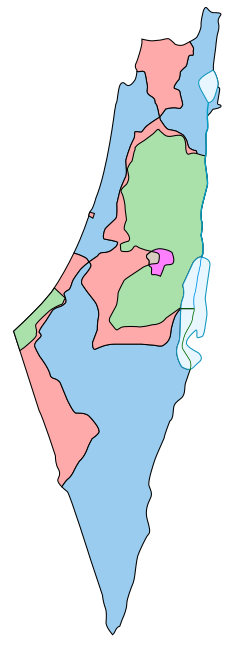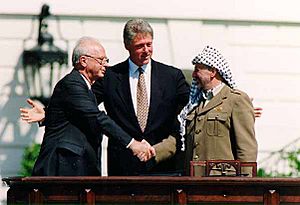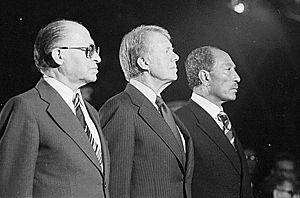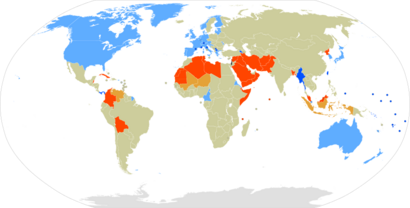Arab–Israeli conflict facts for kids
Quick facts for kids Arab–Israeli conflict |
|||||||||
|---|---|---|---|---|---|---|---|---|---|
| Part of the Middle Eastern conflicts | |||||||||
Primary belligerents: Israel Palestine Other belligerents: Lebanon, Syria, Iraq, and Houthi-controlled Yemen Former belligerents: Egypt and Jordan |
|||||||||
|
|||||||||
| Belligerents | |||||||||
|
|
||||||||
| Commanders and leaders | |||||||||
|
|
||||||||
| Casualties and losses | |||||||||
| See § Casualties for details. | |||||||||
The Arab–Israeli conflict is a long-lasting disagreement between Israel and many Arab countries. It involves military actions and different types of disputes. This conflict mainly started because the Arab League supported the Palestinians in their own conflict with Israel.
Both sides have strong feelings about the land. Zionism is a movement that believes the land is the historic home of the Jewish people. Arab nationalism believes the land belongs to the Arab Palestinian people. These ideas began in the late 1800s. They started to clash directly in the 1920s.
Major fighting mostly stopped after the Yom Kippur War in 1973. Peace agreements were signed between Israel and Egypt in 1979. This led to Israel giving back the Sinai Peninsula to Egypt. Later, Israel and Jordan also signed a peace agreement in 1994.
Over time, the conflict changed. It became more focused on the local Israeli–Palestinian conflict. This conflict reached a high point during the 1982 Lebanon War. Israel entered Lebanon to remove the Palestine Liberation Organization (PLO).
In 2002, the Arab League offered to recognize Israel. This was part of a plan to resolve the Israeli–Palestinian conflict. This plan, called the Arab Peace Initiative, asked Israel to leave occupied lands. It also called for a fair solution for Palestinian refugees.
More recently, the Syrian civil war changed things near Israel's northern border. This created new tensions, especially with Iran. By 2017, Israel and several Sunni Arab countries, like Saudi Arabia, formed a group to stand against Iran. This cooperation and new agreements between Israel and some Gulf states suggest the Arab–Israeli conflict is changing.
Contents
Why the Conflict Started
National Movements and Land Claims
The conflict's roots are in the different ideas of Zionism and Palestinian nationalism. These movements grew at the end of the 1800s. Jewish people see the land as their historic homeland. Many Arabs believe it belongs to the Arab Palestinians. This area, called Palestine, was controlled by the Ottoman Empire for about 400 years.
During World War I, both Jews and Arabs supported the British. They hoped to gain freedom from the Ottomans. This led to the rise of Arab nationalism. Both Arab nationalism and Zionism started in Europe.
In the late 1800s, Jewish people from Europe and the Middle East began moving to Palestine. They bought land from local owners. The population of Palestine was about 600,000 people. Most were Muslim Arabs, but there were also many Jews and Christians. New Jewish farms, called kibbutzim, were created. The first all-Jewish city, Tel Aviv, was also built.
In 1915–16, Britain secretly promised to support an independent Arab state. This was if the Arabs helped them fight the Ottoman Empire. The Arab revolt was successful. Britain then took control of much of the area.
Conflict in British-Ruled Palestine
Early Years and British Rule
In 1917, British forces took control of Palestine. The British government then issued the Balfour Declaration. This statement supported "a national home for the Jewish people" in Palestine. But it also said that the rights of non-Jewish communities should be protected. This declaration worried many Arabs.
After the war, the area became the British Mandate of Palestine. This area included what is now Israel, the West Bank, and the Gaza Strip. Later, Transjordan became a separate British area. It gained full independence in 1946.
A big problem for Arab nationalists happened in 1920. The Arab Kingdom of Syria failed. This led to the start of local Palestinian Arab nationalism. Jewish immigration to Palestine continued. Some Arabs also moved there from nearby areas.
Palestinian Arabs saw the fast increase in Jewish immigrants as a threat. They worried about their homeland and identity. Jewish policies of buying land and not hiring Arabs also caused anger. Protests began as early as 1920. They complained about what Arabs felt were unfair advantages for Jewish immigrants. This anger led to violence. Riots broke out in Jerusalem in 1920.
Growing Tensions and Violence
In 1929, riots started in Jerusalem and spread. Arabs killed 67 Jews in Hebron. This event became known as the Hebron massacre. During that week, at least 116 Arabs and 133 Jews were killed. Many more were injured.
By 1931, Jews made up 17 percent of the population in British-ruled Palestine. This was a six percent increase since 1922. Jewish immigration grew quickly after the Nazis came to power in Germany. This caused the Jewish population in Palestine to double.
In the mid-1930s, Izz ad-Din al-Qassam formed a group called the Black Hand. This group was against both Zionists and the British. He trained peasants, and by 1935, he had hundreds of men. They used bombs and guns to attack Jewish settlers. By 1936, tensions led to the 1936–1939 Arab revolt in Palestine.
Because of Arab pressure, the British limited Jewish immigration. These limits stayed until the end of British rule. This period was during the Nazi Holocaust. Many Jewish refugees tried to enter Palestine illegally. This caused more problems.
After many failed attempts to find a solution, the British asked the United Nations for help. In 1947, the UN suggested a plan to divide the land. It would create a Jewish state and an Arab state. The UN approved this plan. But all six Arab countries in the UN voted against it. On the ground, Arab and Jewish Palestinians fought to control important areas.
Civil War and the Birth of Israel

Boundaries defined in the 1947 UN Partition Plan for Palestine:
Armistice Demarcation Lines of 1949 (Green Line):
Before the British rule ended, Jewish forces gained control of areas the UN planned for a Jewish state. This created many refugees. They captured towns like Tiberias and Haifa.
In early 1948, Britain announced it would end its rule on May 14. The US President suggested a UN trusteeship instead of division. He warned that without action, violence would break out.
History of the Conflict
The 1948 Arab–Israeli War
On May 14, 1948, the British rule ended. The Jewish People's Council declared the State of Israel. This new state was in Eretz Israel. The declaration was made by David Ben-Gurion.
The new state's borders were not mentioned. On May 15, 1948, Arab governments announced they would intervene. They said it was to restore peace and order in Palestine. They wanted a united state of Palestine based on democratic ideas.
That day, armies from Egypt, Lebanon, Syria, Jordan, and Iraq invaded. This started the 1948 Arab–Israeli War. The new Israeli Defense Force pushed back the Arab armies. Israel expanded its borders beyond the original UN plan. By December 1948, Israel controlled most of the land west of the Jordan River. Jordan controlled the West Bank, and Egypt controlled the Gaza Strip.
During this war, about 713,000 Palestinian Arabs left their homes. They became Palestinian refugees. Some left because Arab leaders promised they could return after the war. Others fled due to attacks by Israeli forces and Jewish groups. The war ended with agreements between Israel and its Arab neighbors in 1949.
The situation for Jewish citizens in Arab countries worsened. Anti-Jewish riots happened in December 1947. Many Jews were forced to leave Arab countries. Over 850,000 Jews from Arab countries moved to Israel and other places.
From 1949 to 1967
After Israel's victory in 1948, Arabs on the wrong side of the ceasefire line could not return home. Similarly, Jews in the West Bank or Gaza were forced to leave for Israel. Today's Palestinian refugees are descendants of those who left.
In 1956, Egypt closed the Straits of Tiran to Israeli ships. This blocked the Gulf of Aqaba. Israel responded by invading the Sinai Peninsula with British and French help. During the Suez Crisis, Israel captured the Gaza Strip and Sinai. The US and UN pressured Israel to stop. Israel agreed to leave Egyptian land. Egypt agreed to allow ships to pass freely.
Israel built a large water system in 1964. It was designed to move water from the Jordan river to the south. Arabs tried to divert the Jordan's water sources. This led to more conflict between Israel and Syria.
The PLO (Palestinian Liberation Organization) was formed in 1964. Its goal was to liberate Palestine.
On May 19, 1967, Egypt removed UN observers. It sent 100,000 soldiers to the Sinai Peninsula. It again closed the Straits of Tiran to Israeli ships. On May 30, Jordan signed a defense agreement with Egypt.
On June 5, Israel attacked Egypt. The Israeli Air Force destroyed most of the Egyptian, Jordanian, Syrian, and Iraqi air forces. This was key to Israel's victory in the Six-Day War. After the war, Israel controlled the Sinai Peninsula, Gaza Strip, West Bank (including East Jerusalem), and the Golan Heights. The results of this war still affect the region today.
From 1967 to 1973
In August 1967, Arab leaders met in Khartoum. They decided on "three no's": no recognition, no peace, and no negotiations with Israel.
In 1969, Egypt started the War of Attrition. Its goal was to wear down Israel to get back the Sinai Peninsula. The war ended after Gamal Abdel Nasser's death in 1970. His successor, Anwar Sadat, tried to improve relations with the US. He hoped the US would pressure Israel to return the land.
On October 6, 1973, Syria and Egypt launched a surprise attack on Israel. This was on Yom Kippur, a very important Jewish holiday. The Israeli military was unprepared. Other Arab states sent troops to help Egypt and Syria. These Arab countries also used oil as a political tool. They increased oil prices to gain support against Israel. The Yom Kippur War involved the US and the Soviet Union indirectly. When Israel started winning, the Soviet Union threatened to intervene. The US helped arrange a ceasefire on October 25.
From 1974 to 2000
Peace with Egypt and Jordan
After talks in the late 1970s, Israel and Egypt signed a peace treaty in March 1979. The Sinai Peninsula was returned to Egypt. The Gaza Strip remained under Israeli control. The agreement also allowed Israeli ships to pass freely through the Suez Canal.
In October 1994, Israel and Jordan signed a peace agreement. This agreement called for cooperation and an end to fighting. It also set the border between them. Jordan became only the second Arab country to sign a peace deal with Israel.
Conflicts with Iraq and Lebanon
Israel and Iraq have been enemies since 1948. Iraq sent troops in the 1948 war. It also supported Egypt and Syria in the 1967 and 1973 wars. In 1981, Israel attacked and destroyed Iraqi nuclear facilities. During the Gulf War in 1991, Iraq fired missiles at Israel. Israel did not respond to avoid a bigger war.
In 1970, the PLO was forced out of Jordan. They moved to Lebanon. From there, they launched attacks into Israel. The PLO's presence caused problems in Lebanon. In 1978, Israel launched an operation to push the PLO north of the Litani river. In 1982, Israel invaded Lebanon again. The PLO agreed to leave Lebanon.
In 1983, Israel and Lebanon signed a peace agreement. But Syria pressured Lebanon to cancel it. By 1985, Israeli forces pulled back to a small strip in southern Lebanon. Fighting continued at a lower level. In 1993 and 1996, Israel launched operations against Hezbollah. In May 2000, Israel withdrew from Southern Lebanon.
Palestinian Uprising and Peace Talks
The 1970s saw many international attacks. These included the Lod Airport massacre and the Munich Olympics Massacre in 1972.
In December 1987, the First Intifada began. This was a large Palestinian uprising against Israeli rule. It started in a refugee camp and spread. Palestinians used civil disobedience and some violence. They held strikes, boycotted Israeli products, and threw stones at Israeli soldiers. Israel's strong response led to international criticism. The PLO was invited to peace talks after it recognized Israel and stopped using violence.

In 1993, Israeli and Palestinian leaders held peace talks in Norway. They signed the Oslo Accords. Israel recognized the PLO as the Palestinian people's representative. The PLO recognized Israel's right to exist and stopped using violence.
The Oslo II agreement was signed in 1995. It divided the West Bank into different areas. These agreements are still important today.
From 2000 to 2005
The Al-Aqsa Intifada made Israel rethink its policies. After many attacks, Israel launched a large military operation in March 2002. Israel increased security around the West Bank. It set up roadblocks and checkpoints. This was to stop violence and protect Israeli settlements. However, since 2008, Israel has slowly given authority to Palestinian security forces.
Israel's prime minister, Ariel Sharon, began a plan to leave the Gaza Strip in 2003. This plan was completed in August 2005. This decision was a big surprise. It divided Sharon's own political party.
Shift to Iranian–Israeli Conflict (2006–Present)
Conflicts with Hamas and Hezbollah
In June 2006, Hamas fighters captured an Israeli soldier, Gilad Shalit, near the Gaza Strip. Israel launched an operation to free him. He was held hostage until 2011, when he was exchanged for over 1,000 Palestinian prisoners.
In July 2006, Hezbollah fighters crossed into Israel from Lebanon. They attacked and killed Israeli soldiers and took two hostage. This started the 2006 Lebanon War. The war caused much damage in Lebanon. A UN ceasefire ended the conflict in August 2006. Over a thousand Lebanese and over 150 Israelis were killed. Many people on both sides had to leave their homes.
In June 2007, Hamas took control of the Gaza Strip from Fatah. After this, Israel placed limits on its border with Gaza. Israel and Egypt have had a blockade of the Gaza Strip since 2007. Israel says the blockade is needed to stop rocket attacks and prevent Hamas from getting weapons.
In September 2007, Israel bombed a site in Syria. It was believed to be a nuclear reactor.
In April 2008, Syria and Israel discussed a peace treaty. Turkey helped with these talks. The future of the Golan Heights was also discussed.
In August 2008, the US criticized Israel for building more settlements in the West Bank. This was seen as harmful to peace talks.
A ceasefire between Hamas and Israel ended in December 2008. Attempts to extend it failed. Hamas resumed rocket attacks on Israeli cities. On December 27, 2008, Israel launched Operation Cast Lead against Hamas.
In 2009, Israel stopped building settlements in the West Bank for 10 months. The US praised this as a step towards peace.
In May 2010, Israeli forces stopped ships trying to reach Gaza. On one ship, activists clashed with soldiers. Nine activists were killed. This led to international criticism. Israel then eased its blockade on Gaza.
After peace talks in 2010–2011, Palestinian groups led by Hamas increased attacks. Attacks on Israelis grew after August 2010. Rocket attacks on Israel also increased.
Fighting continued. In November 2012, Israel killed a Hamas leader. This started Operation Pillar of Cloud. Hamas and Israel agreed to a ceasefire. Many Palestinians and some Israelis were killed. Many countries supported Israel's right to defend itself.
In July 2014, Israel started Operation Protective Edge in Gaza after more rocket attacks. In May 2021, another round of fighting happened in Gaza for eleven days.
During the Syrian Civil War
Israel's role in the Syrian Civil War has mainly been missile strikes. Israel is against Iran's presence in Syria. Israel has also given humanitarian aid to Syrian war victims. Iran and its allies, like Hezbollah, are suspected of attacking Israeli positions. Israel is suspected of air strikes against weapon shipments to these groups.
On December 9, 2017, the US recognized Jerusalem as Israel's capital. This caused criticism from other world leaders. The new US Embassy opened in Jerusalem on May 14, 2018.
Normalization with Gulf States and Sudan
An Arab–Israeli alliance began to form by November 2017. This was due to growing ties between Israel and the Gulf States. They shared concerns about Iran's influence in the Middle East. Countries like Saudi Arabia, United Arab Emirates, and Oman were involved. In 2018, Israeli Prime Minister Benjamin Netanyahu visited Oman.
In February 2020, Israel and Sudan agreed to normalize their relations. Later that month, Israeli planes could fly over Sudan. This was followed by the Abraham Accords in August 2020. Israel, the United Arab Emirates, and Bahrain agreed to normalize relations. Israel also agreed to pause plans to annex the Jordan Valley.
During the 2023 Hamas–Israel War, Arab League countries did not officially interfere. The war, started by Hamas, divided the Arab world. Arab leaders condemned Israeli actions in Gaza. However, there was no joint statement calling for peace. Saudi Arabia said it was interested in peace and normal relations with Israel after the war. This would be on the condition of creating a Palestinian State.
Impact of the Conflict
The conflict has had a huge cost. A report estimated the lost economic opportunities for the Middle East from 1991 to 2010 at $12 trillion. If there had been peace, the average Israeli citizen could have earned much more money.
In terms of human lives, it is estimated that 92,000 people died from 1945 to 1995. This includes 74,000 military personnel and 18,000 civilians.
See also
 In Spanish: Conflicto árabe-israelí para niños
In Spanish: Conflicto árabe-israelí para niños
- One-state solution
- Two-state solution
- International law and the Arab–Israeli conflict
- Media coverage of the Arab–Israeli conflict
- Arab League and the Arab–Israeli conflict
- Soviet Union and the Arab–Israeli conflict
- Foreign relations of Israel
- Israel–European Union relations
- Timeline of the Israeli–Palestinian conflict
- Policide
- Muhammad's views on Jews
- Conflict: Middle East Political Simulator
- Civil defense in Israel
- List of wars involving Israel
- Israeli casualties of war
- Palestinian casualties of war
- Palestinian political violence
- Sykes–Picot Agreement
- Zionist political violence
- List of wars by death toll
- History of the Israel Defense Forces



